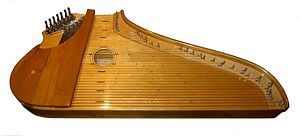Kantele
Rita... I set this up arbitrarily. please feel free to reorganize... D
A kantele ([ˈkɑntele], from Finnish) or kannel ([ˈkɑnːel], Finnish variant or from Estonian) is a traditional plucked string instrument of the zither family. It is related to the Russian gusli, the Latvian kokle and the Lithuanian kanklės. Together these instruments make up the family known as Baltic Psalteries.
Description
The oldest forms of kantele have 5 or 6 horsehair strings and a hollowed out wooden body carved from a piece of alder, pine or spruce. Modern instruments have metal strings, tuning pegs and often a body made from several pieces of wood. Modern concert kanteles can have up to 39 strings. Modern instruments with less than 15 strings are generally more closely modelled on traditional shapes than the concert kantele, and form a separate category of instrument known as small kantele.
The playing positions of concert kantele and small kantele are reversed, ie to the player of a small kantele the longest low pitched strings are furthest away from his body, whilst to a concert kantele this side of the instrument is nearest, and the short high pitched strings furthest away.
The Finnish kantele generally has a diatonic tuning though small kantele with between 5 and 15 strings are often tuned to a gapped mode missing a seventh and with the lowest pitched strings tuned to a fourth below the tonic as a drone. The Estonian Kannel has a variety of traditional tunings. Concert versions have a switch mechanism (similar to semitone levers on a modern folk harp) for making sharps and flats. Players hold the kantele in their laps or on a small table. There are two main techniques to play, either plucking the strings with their fingers or strumming unstopped strings.
History
No-one can accurately say how old an instrument the kantele is, its history goes back from one to two thousand years and was originally connected with rune singing.
Its mythical origins are described in Finland's national epic, Kalevala, where the magician Väinämöinen creates the first kantele from the jawbone of a giant pike and a few hairs from Hiisi's (Devil's) gelding. The music it makes draws all the forest creatures near to wonder at its beauty. The kantele has a distinctive bell-like sound. Later Väinämöinen makes a wooden kantele, strung with the hair of a willing maiden, and its magic proves equally profound. It is the gift the eternal sage leaves behind when he departs Kaleva at the advent of Christianity.
Recent Developments
There has been a strong resurgence of interest in playing the kantele in Finland. Education for playing the instrument is available in schools and music institutes up to conservatories and the Sibelius Academy, the only music university in Finland. Even some artistic doctoral studies are being made at the Academy with traditional, western classical and electronic music. New and orignal music for the kantele has been created by contemporary Finnish composers.
A Finnish luthiery, Koistinen [[1]], has developed also an electric kantele [2], which employs pick-ups similar as those on electric guitars. It has gained popularity amongst Finnish heavy metal artists.
ReferencesISBN links support NWE through referral fees
External links
- Kantele Players Group
- Online version of Carl Rahkonen's doctoral dissertation on the Finnish Kantele
- Virtual Finland: Kantele
- Sibelius Academy
- Finnish Kantele musician Eva Alkula
- English Kantele maker
- Finnish Kantele artist Timo Väänänen
- Timo Väänänen in the Finnish Wikipedia
- Experimental electric kantele group "Memnon"
- Finnish "Kantele metal" artist "Nostatus"
- Finnish ethnic metal band "Poropetra" has its core in kantele
- Finnish folk metal band Ensiferum use Kantele often.
- Finnish nature-wave band Nest
- Kantele Making
- The Kantele shop(USA).
- Kantele music
- Koistinen Kantele - a finnish kantele developer
- 3 Rivers Kanteles kantele group
- Nest
Credits
New World Encyclopedia writers and editors rewrote and completed the Wikipedia article in accordance with New World Encyclopedia standards. This article abides by terms of the Creative Commons CC-by-sa 3.0 License (CC-by-sa), which may be used and disseminated with proper attribution. Credit is due under the terms of this license that can reference both the New World Encyclopedia contributors and the selfless volunteer contributors of the Wikimedia Foundation. To cite this article click here for a list of acceptable citing formats.The history of earlier contributions by wikipedians is accessible to researchers here:
The history of this article since it was imported to New World Encyclopedia:
Note: Some restrictions may apply to use of individual images which are separately licensed.

